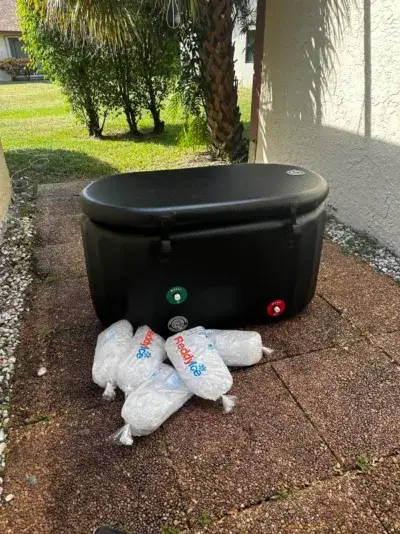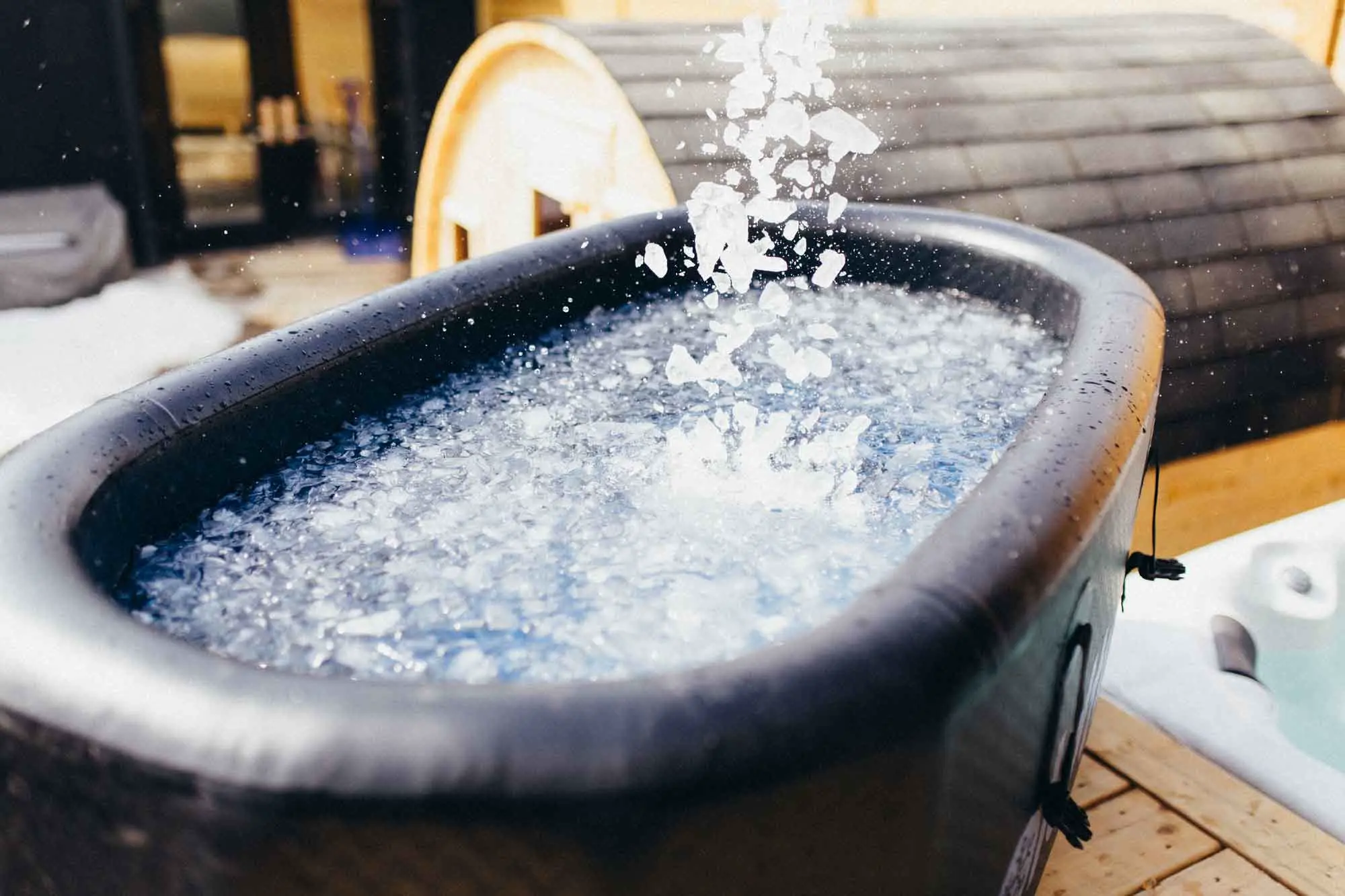Cryotherapy vs Ice Bath: Frosty Recovery Showdown
Cryotherapy vs Ice Bath: Frosty Recovery Showdown
Cryotherapy vs. Ice Bath: Cold Showdown


- Principles:
- Utilizes extremely low temperatures, typically ranging from -110°C to -160°C.
- Aims to trigger physiological responses, including vasoconstriction followed by vasodilation.
- Involves exposure to cold through methods like cryo chambers, ice packs, or liquid nitrogen.
- Effects in Sports Recovery:
- Promotes faster recovery by enhancing blood circulation to the affected areas.
- Reduces muscle soreness and inflammation through vasoconstriction.
- Temporarily numbs nerve endings, providing pain relief.
- Slows down metabolism, aiding in controlling inflammation and promoting healing.
- Duration: Quick exposure, lasting around 2-5 minutes.
Ice Bath:
- Principles:
- Involves immersing the body in cold water, usually with a temperature below 10°C.
- Aims to lower local temperature, slowing down metabolic processes and reducing inflammation.
- Commonly used for post-exercise recovery by athletes.
- Effects in Sports Recovery:
- Induces vasoconstriction, reducing blood flow and limiting inflammation.
- Alleviates muscle soreness and swelling.
- Provides a localized numbing effect, diminishing pain perception.
- Effective in controlling and preventing delayed onset muscle soreness (DOMS).
- Duration: Longer immersion, typically 5-20 minutes.
Evaluating Cost and Accessibility: Cryotherapy vs. Ice Bath
Cryotherapy:
- Cost: Typically ranges from $50 to $400 per session.
- Accessibility: Offered at specialized facilities or wellness centers.
- Considerations: Package deals may be available, but it remains a significant investment. Locations may not be as widespread or convenient as traditional gyms or spas.
Ice Bath:
- Cost: Primarily the price of ice, Or a 1HP Harman N water chiller for ice bath is more appropriately priced – 589USD.
- Accessibility: Can be easily created at home using a bathtub filled with cold water and ice.
- Considerations: Budget-friendly option for recovery therapy. Provides ultimate control over usage, making it convenient for home use without scheduling appointments.
In summary, cryotherapy sessions come with a notable price tag and are typically offered at specialized facilities, impacting accessibility. In contrast, ice baths offer a more budget-friendly alternative that can be easily set up at home, providing greater control and convenience for individuals looking to incorporate cold therapy into their routine without significant financial investment. The choice between the two depends on individual preferences, budget considerations, and the convenience of at-home use.
Understanding Risks and Side Effects: Cryotherapy vs. Ice Bath
Cryotherapy:
- Risk: Frostbite is a primary risk, occurring with prolonged exposure to temperatures below freezing.
- Effects: Potential damage to skin and underlying tissues, leading to pain, swelling, and tissue necrosis.
- Precautions: Essential to follow safety guidelines and limit exposure time to minimize the risk of frostbite.
- Side Effects: Skin irritation or burns may occur, manifesting as redness, itching, or blistering post-session.
Ice Bath:
- Risk: Hypothermia is a common risk due to prolonged exposure to extremely cold temperatures.
- Effects: Drop in core body temperature can lead to symptoms like shivering, confusion, and potential loss of consciousness.
- Precautions: Crucial to monitor time spent in cold water and avoid prolonged submersion to prevent hypothermia.
- Side Effects: Negative effects on skin health, including frostbite, characterized by numbness, tingling sensations, and skin discoloration.
Conclusion: Tailoring The choice To Your Unique Needs

It is recommended to use cryotherapy for acute injuries and post-exercise recovery, while ice baths can be beneficial for reducing muscle soreness and improving circulation. However, individual preferences and tolerance should also be taken into consideration when choosing between the two methods.
If you are interested in ice bath you can contact us at any time, we can provide DIY solutions and the water chiller for ice bath, portable inflatable ice bath tubs, metal wooden ice bath tubs you want to meet your different needs.
“Selling High-Quality Products At Reasonable Profits And Treating Customers With Patience And Professionalism!” That’s what we’re all about! We are committed to helping those in need with faster and more efficient exercise recovery and are always happy to hear from you.
Vestibulum ante ipsum
You also want to know these…
Vestibulum ante ipsum
Cryotherapy vs Ice Bath: Frosty Recovery Showdown
Cryotherapy vs. Ice Bath: Cold Showdown


- Principles:
- Utilizes extremely low temperatures, typically ranging from -110°C to -160°C.
- Aims to trigger physiological responses, including vasoconstriction followed by vasodilation.
- Involves exposure to cold through methods like cryo chambers, ice packs, or liquid nitrogen.
- Effects in Sports Recovery:
- Promotes faster recovery by enhancing blood circulation to the affected areas.
- Reduces muscle soreness and inflammation through vasoconstriction.
- Temporarily numbs nerve endings, providing pain relief.
- Slows down metabolism, aiding in controlling inflammation and promoting healing.
- Duration: Quick exposure, lasting around 2-5 minutes.
Ice Bath:
- Principles:
- Involves immersing the body in cold water, usually with a temperature below 10°C.
- Aims to lower local temperature, slowing down metabolic processes and reducing inflammation.
- Commonly used for post-exercise recovery by athletes.
- Effects in Sports Recovery:
- Induces vasoconstriction, reducing blood flow and limiting inflammation.
- Alleviates muscle soreness and swelling.
- Provides a localized numbing effect, diminishing pain perception.
- Effective in controlling and preventing delayed onset muscle soreness (DOMS).
- Duration: Longer immersion, typically 5-20 minutes.
Evaluating Cost and Accessibility: Cryotherapy vs. Ice Bath
Cryotherapy:
- Cost: Typically ranges from $50 to $400 per session.
- Accessibility: Offered at specialized facilities or wellness centers.
- Considerations: Package deals may be available, but it remains a significant investment. Locations may not be as widespread or convenient as traditional gyms or spas.
Ice Bath:
- Cost: Primarily the price of ice, Or a 1HP Harman N water chiller for ice bath is more appropriately priced – 589USD.
- Accessibility: Can be easily created at home using a bathtub filled with cold water and ice.
- Considerations: Budget-friendly option for recovery therapy. Provides ultimate control over usage, making it convenient for home use without scheduling appointments.
In summary, cryotherapy sessions come with a notable price tag and are typically offered at specialized facilities, impacting accessibility. In contrast, ice baths offer a more budget-friendly alternative that can be easily set up at home, providing greater control and convenience for individuals looking to incorporate cold therapy into their routine without significant financial investment. The choice between the two depends on individual preferences, budget considerations, and the convenience of at-home use.
Understanding Risks and Side Effects: Cryotherapy vs. Ice Bath
Cryotherapy:
- Risk: Frostbite is a primary risk, occurring with prolonged exposure to temperatures below freezing.
- Effects: Potential damage to skin and underlying tissues, leading to pain, swelling, and tissue necrosis.
- Precautions: Essential to follow safety guidelines and limit exposure time to minimize the risk of frostbite.
- Side Effects: Skin irritation or burns may occur, manifesting as redness, itching, or blistering post-session.
Ice Bath:
- Risk: Hypothermia is a common risk due to prolonged exposure to extremely cold temperatures.
- Effects: Drop in core body temperature can lead to symptoms like shivering, confusion, and potential loss of consciousness.
- Precautions: Crucial to monitor time spent in cold water and avoid prolonged submersion to prevent hypothermia.
- Side Effects: Negative effects on skin health, including frostbite, characterized by numbness, tingling sensations, and skin discoloration.
Conclusion: Tailoring The choice To Your Unique Needs

It is recommended to use cryotherapy for acute injuries and post-exercise recovery, while ice baths can be beneficial for reducing muscle soreness and improving circulation. However, individual preferences and tolerance should also be taken into consideration when choosing between the two methods.
If you are interested in ice bath you can contact us at any time, we can provide DIY solutions and the water chiller for ice bath, portable inflatable ice bath tubs, metal wooden ice bath tubs you want to meet your different needs.
“Selling High-Quality Products At Reasonable Profits And Treating Customers With Patience And Professionalism!” That’s what we’re all about! We are committed to helping those in need with faster and more efficient exercise recovery and are always happy to hear from you.
Vestibulum ante ipsum
You also want to know these…
About ther Author

Welcome to our blog! My name is peter and I am the lead author of this blog. As a sport recovery practitioner and with deep interests and expertise.
I am committed to presenting complex concepts in a clear and concise manner, and enabling readers to better understand and apply that knowledge through in-depth research and experience sharing.
Thank you for reading and for your support! If you have questions or suggestions about any of the content, please feel free to contact me. I look forward to sharing more interesting and useful information with you and growing together on this journey of knowledge!
